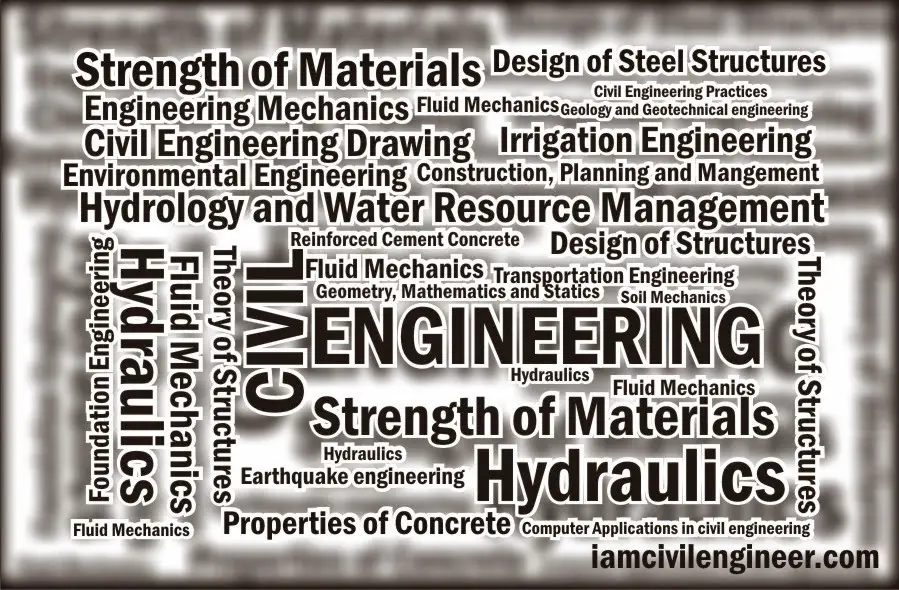Civil Engineering is regarded as mother of all engineering disciplines, not just because it gives birth to other engineering disciplines but also because it explains and allows utilizing the principles of other disciplines of engineering.
Know more about What civil engineering is, what civil engineers do here
\”Civil Engineering is more of a practical education rather than theoretical formulas \”
The term civil engineering was devised decades ago when there were only two types of engineering military engineering and civil engineering, that is also one reason why it is called mother of all engineering disciplines.
 |
| Civil Engineering Subjects Tag Cloud |
@import url(http://fonts.googleapis.com/css?family=Oswald:700); ( function() { if (window.CHITIKA === undefined) { window.CHITIKA = { \’units\’ : [] }; }; var unit = {\”calltype\”:\”async[2]\”,\”publisher\”:\”smsbazaar\”,\”width\”:550,\”height\”:250,\”sid\”:\”Chitika Default\”}; var placement_id = window.CHITIKA.units.length; window.CHITIKA.units.push(unit); document.write(\’
\’); }());
Anyhow civil engineering is a proficient, trained and professional engineering regulation in which civil engineers who might be a graduate, postgraduate or doctorate in Civil Engineering is involved in designing, maintaining, executing and constructing civil works including naturally and manually or physically built environment including roads, bridges, canals, dams, building and structures.
Civil Engineering is being studied throughout the world in various native languages to satisfy the global demand as well as the native demand. It is being studied after 12 years of education sometimes as 3 years or sometimes 4 years of compete graduation degree and few also move to post-graduation and doctorate level as well.
In most of the countries the civil engineering subjects and curriculum is being developed by a competent authority of professors and professional civil engineers.
The curriculum includes some of the credit hours that are specified for social science as well as linguistics together with some specified practical lab work to introduce and equip the young minds with know-how of the fieldwork because the civil engineering is actually more of the practical work with some desk work included as well planning and scheduling the field work.
As far some of the subjects of Civil Engineering is concerned here are some of the subjects along with details and reference books;
Engineering Mechanics
Engineering mechanics is regarded as base for all engineering involving forces and equilibrium along with the relationship between them in physical processes. Mechanics is studied in two branches in civil engineering as kinetics and kinematics. The idea behind teaching this subject to students is to allow them to develop some basic principles that are being used in some advance structural analysis.
Here are some of the books recommended: Hibbler, R.C. Engineering Mechanics, Prentice Hall. (Latest Edition). F.L. Singer, Engineering Mechanics, 4th Edition Harper and Row Publisher.
Computer Programming
Importance of computing in every advance engineering disciplines is by no means ignorable, thus in civil engineering curriculum it is being involved. Some of the course contents include introduction to personal computer setup, programming language and some lab work.
Books recommended are; Gottfried, B.S. Programming with Structured Basics (Schaum Series), McGraw Hill. Deitel & Deitel, T.R. Nieto, Visual C++ 6. Steven Holzner, Black Book Of C++.
English Language Skills
In most of the non-English countries including Pakistan, Bangladesh, Indian, and few others which ensures the language of teaching as English has introduced this course in civil engineering so that it let them easily settle in any of the foreign construction or civil engineering firm.
Course contents are reading skills, types and parts of speech, use of articles, report writing, sentence creation, paragraph writing.
Shafi, S, Mansoor, S and Irfan, H, 1994. Skill Worker: Student Activity Book: B A English for paper B, 1st ed. Caravan Book House Lahore, Pakistan
Applied Calculus / Math-1
To learn fundamentals of mathematics, calculus and analytical geometry. Some of the various contents include; Complex Number, Functions, Differentiation, Partial differentiation, Integral Calculus, Integration Applications, Analytical Solid Geometry.
Books recommended are Schaum’s Series, Calculus, Schum’s Series (Latest Edition), Antom, H. Calculus and Analytical Geometry, Johney Wiley and Sons.
Engineering Surveying
The objective of this subject includes, enabling skills to use modern survey instruments.
The course contents include, Introduction to land surveying, definitions of basic surveying terms, branches and their application, Techniques, Modern methods in surveying, leveling and contouring, surveying Drafting and computations and field work.
Books recommended are; Wolf P.R. & Ghilani C. D. Elementary Surveying – An introduction to Geomatics, 11th Edition, Prentice Hall, USA, 2004. Kvanagh, B. Surveying Principles and Application, Prentice Hall (Latest Edition)
Engineering Surveying
The purpose of studying this subject is to develop a solid base for application of geology to engineering problems. Some of the course contents include; introduction to geology, importance of geology for civil engineering projects, Rocks, formation and classification, weathering and erosion, discontinuity classification, Description of rock masses as thickly bedded or thinly bedded, Role of geology in selection of sites for dams, reservoirs, tunnels, ports/harbors and other civil engineering structures.
Some of the recommended books include; Blyth, F.G.H. Geology for Engineering, English Language Book Society (ELBS) Edward Arnold Ltd.
Engineering DRAWING
The objective of studying engineering drawing includes enabling students to learn basics of engineering drawing, enhancing skills to prepare and understand drawings.
Course content includes introduction to the subject and drawing equipment, lettering and dimensioning, graphic symbols, free hand sketches and isometric views. Method of sections including assembly sections, introduction to machine drawing. Architectural Drawing, Preparation of plan, elevation and sections for simple buildings.
Books recommendedare Parkinson, A.C. A first year Engineering Drawing English Language Book Society. Boughton, B. Reinforced Concrete Details’ Manual (Reference Book) Jensen C.H and Mason F.H.S “drafting Fundamentals” Mc Graw Hill.
Civil Engineering MATERIALS and CONSTRUCTION
The objective of this subject is to let the students get familiar with characteristics of construction materials used in civil engineering. To familiarize students about different construction methodologies to be adopted in carrying out a construction Project. To Develop ability of students to carry out the construction projects according to the specification/drawing.
Some of the recommended books are; Huntington, W.C. Building Construction, John Wiley & Sons. Mitchell. Elementary building Construction, B.T. Batsford Ltd.
Strength of Materials
The basic idea being studying this subject is to enable students to learn basics of material strength and to enhance skills of utilizing material of appropriate strength for civil engineering application.
Course contents include simple stress and strain, stresses in beams, Columns and struts, circular shafts, springs, strain energy.
Some of the recommended books are Pytel, A. & F.L Singer, Strength of Materials, Harper & Row Publishers, New York. Hibbler R.C. Strength of Materials.
Fluid Mechanics
The objective behind studying this subject is ; enable students to learn basics of fluid mechanics for civil engineering applications. Course contents include; introduction to fluids, units and dimensions, fluid statics, forces on immersed bodies, fluid kinematics, steady and unsteady flow, Hydrodynamics, flow measurement, steady flow through pipes, uniform flow in open channels.
Some recommended books are.
Daugherty, R.L., J.B Franzini and Fenimore, Fluid mechanics with Engineering Applications, McGraw Hil New York.
Quantity Surveying and ESTIMATION
This subject is also studied under title, drawing estimation and construction. The purpose behind studying this subject is to enhance the ability of students to learn the various principles of computation. To enhance skill of students in preparing details estimates and bill of quantities for various civil engineering projects. To familiarize students with tender and contract documents.
Some of the recommended books includes S.Dutta, Estimating and Costing in civil engineering. D.D. Kohli Estimating, Costing and Accounts. Keith Collier, Fundamentals of Construction, Estimating and Cost accounting.
STRUCTURAL ANALYSIS
This subject is also studied as Theory of Structures (TOS) in two parts one part per semester. The purpose behind this subject is to enable students to learn basics of analysis of determinate structures. To enhance skills of analyzing structures for environmental engineering application.
Some of the course contents includes introduction to structural analysis, analysis of determinate beams, analysis of pinned joined structures, analysis of statically determinate rigid joined plane frames, moving loads, three hinged arches, cabals and suspension bridges. Rotation and Deflect.
Some of the books recommended are; H.H West, fundamentals of structural analysis John Willey – New York.
R.C. Hibbler, Structrual Analysis, John Wiley and Sons inc.
Soil Mechanics
The purpose behind studying the subject is to apply laws of mechanics to soils so that the engineer can design and construct safe structures on or with soil. Some of the contents include introduction, index properties of soil, soil classification, Geotechnical investigation, permeability and seepage, stress distribution in soils, Shear strength.
Books recommended includes; Braja M. Das, Principles of Geotechnical Engineeirng, Thomson- Engineering. Donald P.Coduto Geotechncal Engineering (Principles and Practices).
PLAIN and REINFORCED Concrete
This subject is also studied by the name “Properties of Concrete” and then “Reinforced Concrete”
The contents includes, constituent materials and peoperties, basic principles of reinforced concrete, Working stress method of analysis, ultimate strength method, shear in beams, bond, anchorage and development length, columns and footings.
Hassoun, M.N. Design of Reinforced Concrete Structures, PWS Engineering. Arthur H Nilson, David Darwing, Charles W. Dolan, Arthur Nilson, Charles Dolan, Design of Concrete Structures.
Environmental Engineering
This subject is included so as to learn principles of environmental engineering and inculcate abilities for design and implementation of water supply schemes.
Course content includes; introduction to environmental engineering, water pollution, Water demand and supply, water quality, Water sampling and Testing, Water treatment, Miscellaneous Water Treatment techniques, Water distribution, introduction to noise and air pollution,
Books recommended includes, Mackenzie L. Davis, David A. Cornwell, introduction to environmental engineering.
Transportation Engineering and Management
The purpose is to provide background knowledge of transportation engineering with detailed and thorough understanding of framework of various transportation systems.
Course content includes, introduction to transportation systems, railway engineering, airport engineering, coastal engineering
Books recommended are . Jason C., Yui Transportation engineering introduction to planning, Design and Operations, Elsevier
Hydrology and Water Management
The purpose of the subject is to enable students to learn broad areas of hydrological engineering and principles of water management particularly in irrigated agriculture.
Course contents includes, introduction, meteorology, Precipitation, Evaporation and Transpiration, Stream flow, Runoff, Hydrographs, Steam Flow Routing, Groundwater, Water Management.
Books includes, Warren Viessman, Jr. And Gary L. Lewis, Introduction to Hydrology, R.K. Linsely, Max A. Kholer, and Joseph L. Paulhus, Hydrology for Engineerings, Water Resource Engineering by David, A. Chin, John Wiley & sons
Construction Management
The purpose of studying construction management is to develop ability of students in planning and management techniques for various project. To provide basic concepts of economic analysis of different subjects.
The course content includes, introduction, project planning, scheduling and controlling by deterministic models and probabilistic models, Fundamentals of Engineering Economics,
Books recommended includes Martin Rogers, Engineering Project Appraisal, Blackwell Science, Blank, L.T & Anthony J. Tarquin Engineering Economics, McGraw Hill Book Co.
Some other electives includes, hydraulic engineering, steel structures, irrigation engineering and drainage engineering, foundation engineering, design of structures, computer applications in civil engineering etc.


















